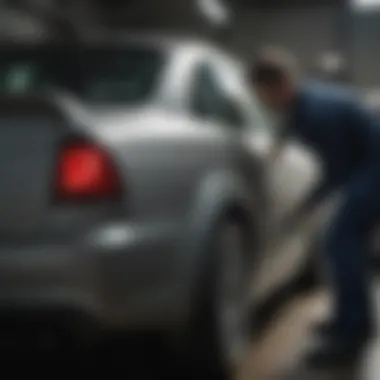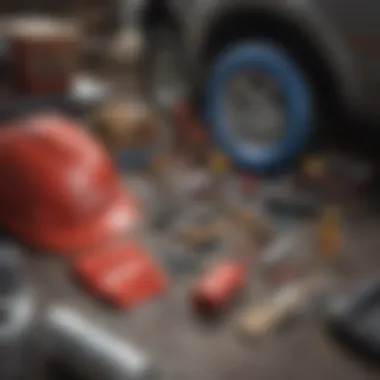Understanding Car Fender Painting Costs: A Complete Guide


Intro
Car fender painting is a critical aspect of vehicle maintenance and aesthetics. Many vehicle owners find themselves needing this service due to various factors such as damage, rust, or simply the desire to refresh the car's appearance. Understanding the costs associated with this process can help individuals make informed decisions and budget effectively.
The factors influencing car fender painting costs are numerous. These vary from the complexity of the damage and paint type to labor costs and location of the service. Additionally, distinguishing between professional services and do-it-yourself approaches can have a substantial impact on the total expenditure involved.
In the following sections, we'll examine specific aspects of car fender painting, highlighting key points while enhancing our understanding of various influences on costs. From types of paint and materials used to pricing structures, this guide offers a comprehensive look that will empower readers to navigate the financial considerations tied to timely and effective fender painting.
Preamble to Car Fender Painting Costs
Car fender painting costs are rarely a subject of deep investigation until one faces the unfortunate moment of needing car repairs. This article aims to uncover the aspects that contribute to the cost of repainting a car fender. Various factors such as the extent of damage, the type of vehicle, quality of materials, and the choice between professional services or a DIY approach, all impact total expenses.
Understanding these factors is not just about budgeting; it actively aids any vehicle owner in making informed choices. Whether you are considering a minor touch-up or a full fender restoration, grasping the intricacies of painting costs provides clarity and confidence in decision-making. The following sections deepen into specifics that ultimately safeguard financial investments in automotive bodywork.
Definition of Car Fender Painting
Car fender painting refers to the process of applying a specific type of paint to the fender area of a vehicle. Fleets or personal vehicles may undergo this when the fenders show signs of damage, peel, corrosion, or fading. Properly done, it can restore aesthetic appeal and enhance longevity against corrosion or rust.
Key elements include surface preparation, painting techniques, and choosing appropriate protective coatings. A well-executed fender painting not only improves looks but also protects against elements that wear down the metal.
Importance of Fender Aesthetics
Fender aesthetics play a vital role in the overall appearance and value of the vehicle. A freshly painted fender can convey an image of care and attention to detail. This is significant, especially when considering resale value. A vehicle with noticeable blemishes may suggest neglect, thus reducing its desirability.
Moreover, aesthetics enhances day-to-day user satisfaction. The visual appeal impacts the enjoyment of driving and pride of ownership of the car. When financial decisions must be made regarding repairs and aesthetics, these considerations are equally important. Professionals often argue that investing in quality services pays off in assessing vehicle aesthetics as an integral aspect.
Factors Influencing Painting Costs
The cost of car fender painting can vary widely based on several key factors. Understanding these elements helps potential customers gauge what to expect financially. Consideration of these factors plays a significant role in achieving a satisfactory outcome in terms of aesthetic results and cost efficiency.
Extent of Damage
The condition of the fender has a direct impact on the final price. Minor scratches will require less preparation and paint, while deeper dents may necessitate extensive repair work. If there is rust, it may need to be treated before any painting occurs. Customers need to assess the severity of the damage first.
- Small scratches can typically range in price from $100 to $300.
- Medium damages might inflate costs into the range of $300 to $700.
- Severe damage, necessitating replacement or extensive repair, could easily exceed $700.
Type of Vehicle
Different vehicles also incur varying painting costs. For example, luxury or imported brands might use specialized paint that can raise the overall price. The size and type of the vehicle matter as well.
For instance:
- Compact cars tend to have lower costs related to fender painting due to smaller surface area.
- SUVs and trucks, having larger fenders, will naturally cost more.
- Sedans usually fall in the mid-range.
Quality of Paint Used
The quality of the paint selected for the job contributes significantly to the total cost. Professional body shops often provide multiple paint options. Understanding the differentiation among those choices can help make informed decisions:
- Standard paints are typically acrylic or enamel, providing basic protection and appearance.
- Premium paints, such as those with a higher solid content or that offer a custom finish, will command a higher price, ranging from $500 to $1,200 based on quality.
High-quality paints not only enhance necessity but are also more durable, ensuring the final product will withstand wear over time.
Labor Costs and Expertise


Labor costs can vary based on the experience of the technicians. More experienced professionals may charge higher rates due to their skills and efficiency. Other costs can influence this aspect more subtly:
- Local Labor Rates: In high-cost living areas, labor fees are npormally higher.
- Type of Service Needed: Restoration services will typically cost more than simple repainting or touch-up jobs.
It can be prudent for consumers to get quotes from different shops. Understanding the profession's requirements helps in judiciously budgeting and ensuring the quality of work.
"A detailed understanding of all these factors allows customers to evaluate various options effectively, making them better prepared to handle costs."
Cost Breakdown of Fender Painting
Understanding the cost breakdown of fender painting is crucial for vehicle owners looking to maintain both the aesthetics and value of their cars. When you break down costs, you can identify areas for potential savings, optimize your budget, and anticipate any unexpected expenses that may arise.
In this section, we will examine several key components of the costs associated with car fender painting: the materials needed, labor charges, and hidden costs. A clear awareness of these factors will enable you to make informed decisions about fender repairs and ensure that your financial planning is solid.
Materials Needed
The materials required for fender painting go beyond just the paint itself. Many elements must be factored into the overall costs:
- Primer: Essential for preparing the surface and promoting adhesion. Good quality primer is often crucial for achieving a durable finish.
- Base coat: This is the actual color layer that provides the desired look. The type of paint may have a significant impact on the end result and cost.
- Clear coat: A clear finish creates added protection and sheen, further safeguarding the underlying color.
- Sandpaper and Restoration Products: Used for surface preparation and to address any imperfections.
- Masking Tape and Paper: Vital for protecting areas around the fender that should not be painted.
Considering these materials accumulatively aids significantly in determining the price. Higher quality materials typically translate into improved finishing and longevity. Thus, making the right choices is important.
Labor Charges
Labor cost constitutes a significant portion of the expense in fender painting. The final charge depends on the complexity of the task and the hourly rates of workshops. Important points include:
- Skill Level of the Technician: Experienced professionals can potentially reduce the risk of mistakes, leading to a better final product.
- Time Requirement: More extensive damage or intricate paint designs can lead to higher labor hours.
- Shop Overhead: Facilities often add fees for their tools, space, and other expenses, which may reflect in the overall charge.
Typical labor charges can range markedly. It is prudent to gather multiple quotes to understand the market and find competitive pricing.
Hidden Costs
Aside from the evident expenses, hidden costs may exist in fender painting projects. These can surprise many car owners:
- Surface Preparation Costs: Additional preparation may be required if rust or previous paint needs removal, inflating costs.
- Environmental Fees: Some areas may have regulations that incur fees related to waste disposal or emissions.
- Color Matching Fees: For touch-ups or if paint requires special mixing, additional charges apply for matching
- Warranty or Guarantees: Gaining some level of assurance on work quality may add an extra cost.
Being aware of these hidden costs can safeguard against budget overruns. While assessing fender painting costs, make sure to inquire about potential hidden charges.
By exploring these components, you can fully better assist in estimating fender painting projects, clearly enhancing your understanding regarding budgeting for this necessary vehicle maintenance.
Comparing Professional Services vs.
DIY
In the realm of car fender painting, the choice between hiring professionals and undertaking a do-it-yourself (DIY) approach can significantly affect both the outcome and the overall costs. Understanding the pros and cons of each method is crucial. Professional services can provide you with numerous benefits, such as expertise and access to high-quality materials, but this comes at a higher price. Conversely, while DIY painting might seem cost-effective, it often presents various challenges that could compromise quality. Each option carries weighty considerations depending on fiscal capacity, desired results, and personal skills.
Benefits of Professional Services
Engaging a professional service for car fender painting assures a host of advantages that are difficult to replicate at home. First, skilled professionals bring years of experience. They can assess the situation meticulously, ensuring repairs address the problem correctly, saving potential costs from mistakes.
Furthermore, professionals utilize advanced tools and applications. Their access to industry-grade materials often translates to a more durable finish, making it a prudent investment for long-term vehicle care. Moreover, guests expect a certain level of aesthetic appeal. Experts can match paint colors and textures effectively. This is exceptionally important for those sensitive to visual detail. Lastly, professional services often include warranties or guarantees, adding more peace of mind related to the investment.
Challenges of DIY Painting
While DIY painting may manifest as an attractive solution, several hurdles could arise that detract from the experience. Firstly, many individuals underestimate the technical skill required for an apt color match or proper paint application. Missteps in these areas can lead to noticeable imperfections that diminish the vehicle's aesthetic.


Moreover, the quality of readily available materials may not hold up to professional-grade products. A scant understanding of the necessary prep work is another frequent challenge and often results in inadequate surface preparation. This can cause the paint to chip away quickly, leading to further expenses down the line. Lastly, the time investment should not be overlooked. The task could easily extend longer and require more effort than initially anticipated, impacting other commitments.
When to Consider Each Option
Deciding whether to hire professionals or tackle a DIY project varies for each individual. If your fender has minimal damage and you possess a helpful hand for routine tasks, a DIY approach can suffice. Simple tasks such as touch-ups may be manageable without extravagance in tools or expertise. Conversely, in cases of significant damage or if the vehicle's appearance plays a critical role in value, opting for professional services may yield better long-term results. Also, if time is not abundant in one’s schedule, seeking help often leads to more efficient outcomes.
Casting a thought on one's ability and job assessments is key. Making the most educated decision goes a long way in ensuring satisfaction with the end result and addressing respective budget expectations.
- Engaging professionals may incur higher immediate costs but tends to deliver lasting results, while DIY can protect short-term budgets at risk of future expenses due to quality issues.
When confronting the question of professional services or DIY, consider factors such as comfort with painting, desired quality, and aesthetics alongside how much time can is going to be invested before any decision is made.
Regional Variations in Painting Costs
Understanding the regional variations in car fender painting costs is crucial for several reasons. These variations can significantly impact the price you pay based on where you live. Different areas have different supply, demand, labor availability, and cost of living conditions that affect pricing in the auto body industry. Knowing this helps consumers to avoid overspending and make logical choice when budgeting for fender painting.
Cost Differences Across Regions
Paint pricing is not universally constant. It can shift dramatically from one region to another. For instance, major city areas often have higher costs because of increased business expenses. In contrast, rural areas may see more competitive pricing due to lower overheads. Certain regions might specialize in specific vehicle types, influencing the cost further through niche services and products.
In metropolitan environments, the average price for a fender painting might be anywhere from $400 to $900 depending on the exact service's intricacy. Meanwhile, consumers in smaller towns might find services ranging from $250 to $600 for similar work, especially if they need only basic repairs with a quickly available service.
It's also common to see artifical extremes in pricing due to local laws. For example, cities with stricter environmental regulations may have higher costs due to compliance requirements, which could impact painter supplies or disposal methods. This plays an important role in consumers understanding the geographical influences on costs.
Impact of Local Economy
The local economy drastically influences service costs, including car painting. Regions experiencing an economic boom often witness a rise in costs. Demand surpasses supply in some situations, pushing prices upwards. In contrast, areas with high unemployment or stagnant growth may see reduced rates as businesses seek to attract customers.
Aspects of the local economy may include:
- Affluence of residents: Wealthier communities usually pay higher service costs.
- Cost of Labor: In places where wages are high, service costs reflect that.
- Business competition: More choices often lead to decreased prices.
It’s also essential to factor in seasonal influence when considering the economy. In places where tourism plays a significant role in the economy, shifts in seasons may affect local pricing patterns due to changes in demand.
So when planning to fender painting, taking special note of your local economy is key. It not only helps establish a baseline cost but also offers insights into the health of the market in your area.
Insurance Considerations
Understanding car fender painting costs inevitably leads to the topic of insurance. Insurance considerations play a significant role in evaluating expenses related to fender damage repair. This section discusses how insurance impacts overall cost, helping readers navigate their decisions effectively when damage occurs.
Filing Claims for Fender Damage
When a vehicle suffers damage, car owners might consider filing a claim with their insurance company. This process entails several steps that require clear documentation. Paiently documenting the damage is crucial; fotos taken at different angles ensure that limportant details are not overlooked.
1. Assess the Damage:
Evaluate the extent of the damage and obtain estimates from professional painters or garages. An informed example empowers better negotiation with duitis.
2. Review Your Policy:
Check if the policy covers fender damage and understand the framework for claims. This step often involves assessing both deductible amounts and premium impacts after claims.
3. Contact Your Insurance Agent:
After understanding coverage, promptly report the damage to your insurance provider. Exact timelines can vary, but timely reporting typically facilitates smoother processing.
4. Submit Required Documentation:
Provide your insurance company with all necessary documents, which might include loss reports, estimates from repair shops, and photos of the damage.


A key benefit of filing a cclaim is often the financial aid it provides in repairing damages. Yet, those using insurance must also be aware of potential sixteffects of claims, such as increases in policy premiums.
Understanding Coverage Limits
When it comes to insurance, understanding your coverage limits is paramount. Many car insurance policies include various types of coverage. Here is an overview of standard coverages relevant to fender painting:
Liability Coverage
This type safeguards against damage you may do to others’ property and vehicles. However, it does not cover your own car's damage, including fender work.
Collision Coverage
This is essential for repairing your vehicle from accidents. Collision coverage often covers fender damage. Knowing deductible amounts assists in determining how much an ow need to fork out beyond gettting paintwork.
Comprehensive Coverage
Comprehensive coverage handles damage unrelated to collisions, such as theft or weather-related damages. Assessing the applicability to fender painting is especially important for places prone to these events.
Uninsured Motorist Coverage
This type also does not specifically target fender painting. However, knowing we'll be protected when involved with an un-insured individual is critical. Ultimately, it is wise to regularly review and adjust your coverage based on your vehicle's condition and coverage needs. Careless policies lead to unexpected out-of-pocket costs when it comes time for paint repair.
Insurance considerations around fender repairs can be complex. Yet, navigation through this terrain helps reinforce financial preparation. Understanding how filing claims works alongside being knowledgefull of coverage limits empowers car owners as they assess repair costs efficiently.
Long-Term Maintenance and Costs
Long-term maintenance and understanding costs associated with car fender painting are critical points of focus for vehicle owners. Preserving the condition of the paint not only keeps aesthetic appeal but also protects the investment. Knowing how consistent upkeep can mitigate future expenses is essential.
Preventive Measures to Reduce Costs
Taking preventive measures can help significantly reduce long-term costs on fender maintenance. Here are specific actions that can be taken:
- Regular Washing: Washing the car frequently can eliminate dirt and grime that may degrade the paint. Using the appropriate soap is important to prevent damage.
- Wax Application: Applying wax every few months provides a protective layer against UV rays and contaminants. This is a simple yet effective step to extend paint life.
- Proper Parking Location: Parking in a garage or shaded area can protect the car's exterior from sun damage. Avoiding dust or debris exposure can also help maintain the paint.
- Quick Repair Sealing: Addressing scratches or chips immediately with suitable touch-up paint or sealants mitigates the opportunity for rust.
These small yet impactful actions can greatly influence the longevity of the paint leading to lower overall costs.
Impact of Climate on Paint Durability
Climate factors play a significant role in the durability of the paint on a car. Different weather conditions can dramatically affect how the paint retains its luster and adherence. Consider the following impacts:
- Heat and UV Exposure: Intense sunlight can lead to fading colors if the paint is not carefully maintained. Ultraviolet rays contribute to oxidization, which diminishes shine.
- Cold Weather Effects: Cold temperatures may lead to paint cracking. Moisture combined with freezing temperatures can exacerbate issues, along with causing surface paint bubbling.
- Humidity Concerns: High humidity levels can contribute to paint peeling or bubbling if moisture gets trapped under the surface. Proper ventilation can help, but that may not always be effective.
By understanding weather influences, one can tailor maintenance activities to manage longevity effectively. Painting might initially seem like a considerable expense, but with these insights on long-term maintenance, vehicle owners can minimize additional financial burdens linked to repaints or repairs.
Culmination
Understanding the costs associated with car fender painting is essential for anyone who wishes to maintain their vehicle's aesthetics and durability. This article presented a comprehensive breakdown of various contributing elements, demonstrating how each factor plays a role in determining overall expenses. Whether considering professional services or the DIY route, it was highlighted that every choice has specific implications for costs and quality of work.
Summary of Key Takeaways
In summary, here are the major points to take away from this guide:
- Extent of damage directly affects the painting costs, with more damages leading to higher expenses.
- Vehicle type can change the cost, as different models may necessitate varying approaches and materials.
- The quality of paint selected is paramount: high-quality materials often guarantee better durability.
- Labor costs vary based on the expertise of the painter, and reputable shops usually have increased prices for their superior skills.
- Regional variations will influence costs, usually aligning with economic factors local to each area.
- Financing aspects, especially concerning insurance coverage, merits careful consideration when budgeting for repairs.
“A conscious awareness of these factors can facilitate meaningful decision-making, resulting in better management of vehicle-related costs.”
Final Thoughts on Budgeting for Fender Painting
When constructing a budget for fender painting, incorporating all potential costs is crucial. Not just the obvious expenses like materials and labor, but also hidden costs that can leap out unexpectedly. Evaluating insurance policies is wise—it might assist in alleviating out-of-pocket spending. Meanwhile, consider future maintenance and preventive methods to protect the paintwork. This foresight can save a considerable amount over time, ensuring your investment in the appearance and longevity of your vehicle is valuable and impactful.
Overall, engaging with this information allows individuals to assess their needs better, promoting informed decisions that align with both financial planning and personal convenience.







